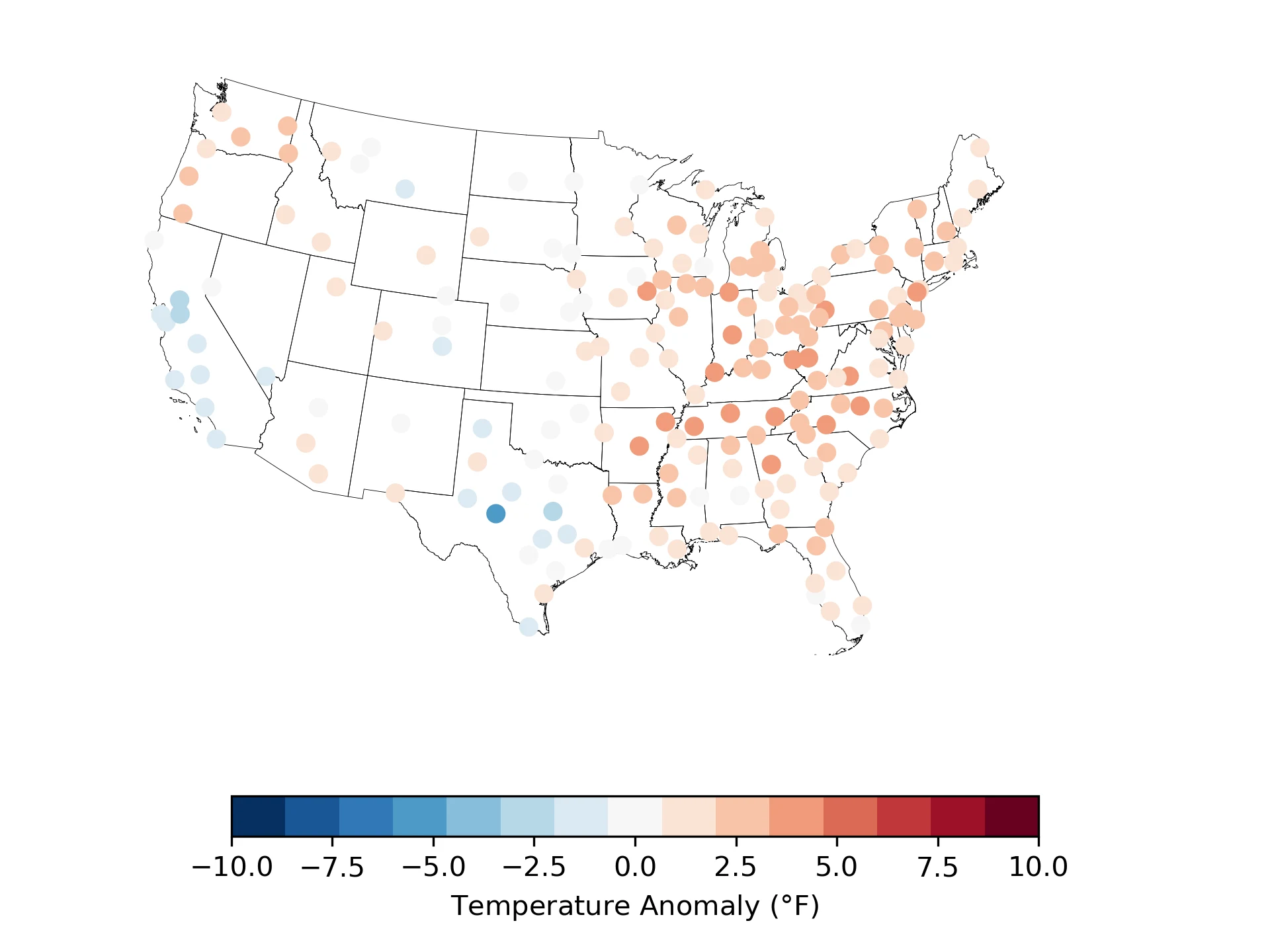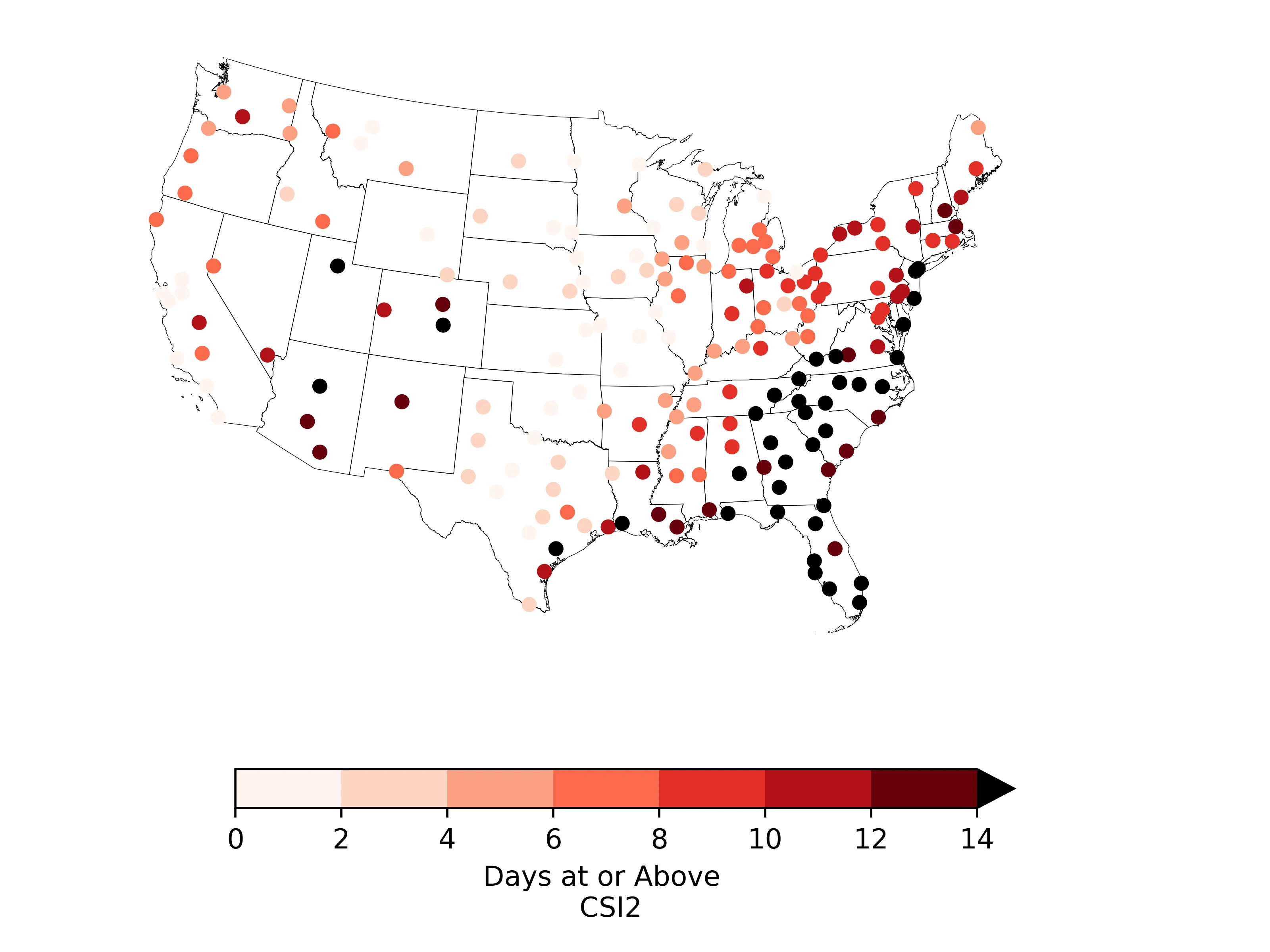Report•August 4, 2025
Monthly Attribution Overview - July 2025
An analysis of how climate change boosted United States temperatures in July 2025
Using Climate Central’s Climate Shift Index (CSI) tool to measure the impact of climate change on daily temperatures across the United States, as well as NOAA’s Applied Climate Information System (ACIS) to find daily temperature information, we have compiled a high-level overview of how climate change has affected temperature trends in July in cities across the United States. (Dataset downloadable as Excel workbook here.)
1. High-Level Findings
The U.S. saw elevated temperatures in July, with an average anomaly — or difference from normal — of 1.4°F across 192 cities.
Twenty-four cities experienced one of their top five warmest July temperatures on record. On average, stations have data reaching back to 1893.
Elevated Climate Shift Index values were observed across the Southwest, South, Southeast, Northeast, and Ohio Valley/Upper Midwest.
Forty-six cities experienced at least two weeks with CSI values of 2 or higher, indicating a strong climate change influence.
Long-term July warming trends show that nearly all cities analyzed have warmed since 1970, consistent with findings from Climate Central’s 2025 Summer Package.

Figure 1. Threaded ACIS temperature anomalies (differences from normal) for July 2025 relative to the 1991-2020 normal. Analysis based on ACIS data.

Figure 2. Days with a CSI of 2 or higher for July 2025 for ACIS threaded stations. Analysis based on ERA5 data (7/01 - 7/30) and GFS data (7/31).
2. Local Temperature Anomaly Analysis
The average temperature anomaly — or difference from normal — across the 196 cities analyzed was 1.4°F. The majority (161 cities) recorded hotter-than-average temperatures.
Temperatures were especially elevated across the eastern half of the U.S., where every city experienced above-average temperatures. The most unusually hot region was the Ohio Valley — which includes West Virginia, Tennessee, Ohio, Illinois, Missouri, Indiana, and Kentucky — with an average temperature anomaly of 2.4°F.
The West was the only region that was cooler than normal, with temperatures 1.36°F below normal.
The most unusually warm city in July was Charlotte, North Carolina, which was 4.6°F warmer than usual.
Of the 196 ACIS stations analyzed, 189 showed warming trends for July, indicating that these cities have been warming on average since 1970.
Reno, Nevada, saw the greatest warming since 1970 — the average July there is now 12.5°F warmer than it was in 1970.
Table 1. Top 10 ACIS stations with the highest July 2025 temperature anomaly.
City | State | Temperature Anomaly or Difference from Normal (°F) | Average Temperature (°F) | Warming Since 1970 (°F) |
|---|---|---|---|---|
Charlotte | NC | 4.6 | 84.7 | 3.2 |
Huntington | WV | 4.5 | 80.9 | 2.1 |
Newark | NJ | 4.0 | 82.1 | 3.1 |
Pittsburgh | PA | 3.9 | 77.0 | 3.2 |
Jackson | TN | 3.9 | 83.4 | 0.2 |
Jonesboro | AR | 3.7 | 85.5 | 0.8 |
Knoxville | TN | 3.7 | 82.2 | 2.2 |
Indianapolis | IN | 3.7 | 79.5 | 1.7 |
Little Rock | AR | 3.7 | 85.1 | 1.7 |
Evansville | IN | 3.6 | 82.3 | 0.9 |
Table 2. Top 10 ACIS stations with the fastest warming July since 1970.
City | State | Warming Since 1970 (°F) | Temperature Anomaly or Difference from Normal (°F) | Average Temperature (°F) |
|---|---|---|---|---|
Reno | NV | 12.5 | 0.1 | 77.2 |
Boise | ID | 8.4 | 0.8 | 78.1 |
Salt Lake City | UT | 7.5 | 1.8 | 82.9 |
Helena | MT | 7.3 | -0.2 | 70.4 |
Wheeling | WV | 7.0 | 3.0 | 76.1 |
Medford | OR | 6.4 | 3.2 | 78.3 |
Spokane | WA | 6.0 | 2.5 | 73.5 |
Yakima | WA | 6.0 | 2.1 | 74.5 |
Las Vegas | NV | 5.8 | -0.8 | 92.5 |
Missoula | MT | 5.4 | 1.5 | 70.0. |
3. Local Climate Shift Index Analysis
San Juan, Puerto Rico had 19 days at CSI 5 in July, indicating that temperatures on those days were made at least five times more likely because of climate change.
Forty-six cities across the country experienced at least two weeks of days at or above a CSI 2.
On average, cities in the Southeast experienced the highest number of days (17) with a CSI of 2 or above.
Table 3. Top 10 ACIS stations with the highest number of days at or above a CSI 2 during July 2025.
City | State | Days at CSI 2 or higher | Days at CSI 5 | Average Temperature (°F) | Temperature Anomaly or Difference from Normal (°F) |
|---|---|---|---|---|---|
San Juan | PR | 29 | 19 | 83.7 | 0.6 |
Honolulu | HI | 29 | 21 | 81.8 | 0.2 |
Bristol | TN | 28 | 6 | 78.0 | 2.4 |
Knoxville | TN | 27 | 1 | 82.2 | 3.7 |
Greenville | SC | 23 | 3 | 83.1 | 3.3 |
Gainesville | FL | 22 | 13 | 84.1 | 2.8 |
Tampa | FL | 22 | 15 | 85.6 | 1.8 |
Tallahassee | FL | 22 | 9 | 84.6 | 2.0 |
Atlanta | GA | 22 | 1 | 84.3 | 3.4 |
Asheville | NC | 22 | 0 | 78.0 | 2.9 |
West Palm Beach | FL | 21 | 12 | 84.4 | 1.4 |
METHODOLOGY
Calculating the Climate Shift Index
All Climate Shift Index (CSI) levels reported in this brief are based on daily average temperatures and ERA5 data. See the frequently asked questions for details on computing the Climate Shift Index, including a summary of the multi-model approach described in Gilford et al. (2022).
City Analysis
We analyzed 191 Applied Climate Information System (ACIS) stations associated with U.S. cities. For each city, we found the CSI time series from the nearest 0.25° grid cell. We calculated the number of days at CSI levels 2, 3, 4, and 5. We used ACIS data to find the average monthly temperatures, temperature anomalies (compared to 1991-2020 normals), and precipitation information, and to derive average monthly warming trends for each city.
Regions
Regions are defined by the National Centers for Environmental Information climate regions.
